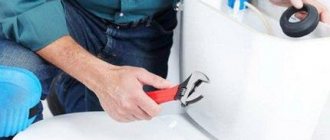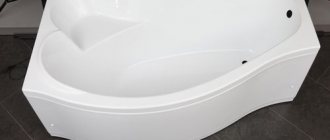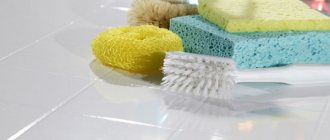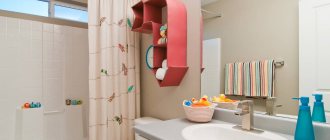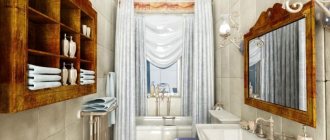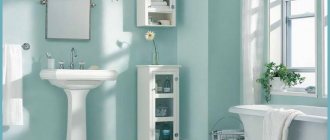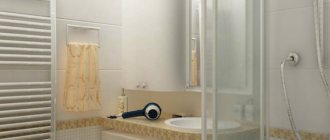The fact that black and gray plaque on the walls and ceiling in the bathroom is unaesthetic is not the biggest problem. It causes the greatest harm to health. The consequences of toxic spores getting into the lungs or bronchi can be the most unpredictable. Treatment after this will require long and serious treatment.
Therefore, if black mold is found in the bathroom, how to get rid of it must be decided immediately. Otherwise, it will quickly penetrate deep under the tiles, and it will not be easy to remove it from there. Our article is dedicated to ways to combat fungus - in this material we examined in detail the best store-bought and folk remedies for removing mold at home.
They also provided useful recommendations on the use of antiseptics and described preventive measures that can prevent the formation of fungus in the bathroom.
Why does mold appear in the bathroom?
The main factor responsible for the formation of dark plaque is high humidity. It is impossible to eliminate it only if you stop using this room altogether. Additional ventilation helps partially solve the problem. It is also recommended to wipe down the bathroom after every shower. However, this is not always enough, since there are always wet towels and so on hanging in this room.
Other causes of mold include:
- Lack of sunlight. As you know, ultraviolet light has disinfecting properties, so it actually destroys many harmful microorganisms. If there are no windows in the bathroom, then in conditions of high humidity, microbes and fungus grow many times faster.
- Improper finishing work. For example, some builders save on materials and do not treat walls with special antiseptics and waterproofing compounds. When working independently, people also often seal tile joints incorrectly or poorly.
- The room is heated too much. Moisture, lack of daylight and heat are the most favorable environment for microorganisms.
- Damage to the drainage system. If the faucet is constantly leaking in the bathroom, and a puddle forms under the bathtub, then after a while mold will appear.
As you can see, it is very difficult to completely exclude the possibility of the appearance of such microflora. Therefore, you need to periodically inspect the room and, at the first sign of black mold, begin removing it.
How to prevent mold?
This uninvited guest feels comfortable in a room where there is absolutely no ventilation and drafts in conditions of high humidity - from 80% and a temperature of 20⁰. Based on this, it is necessary, first of all, to create an environment in which mold cannot develop in principle.
To maintain constant humidity levels in the bathroom, you do not need to close the door tightly. If this measure is not enough, you will have to arrange ventilation. You can install a door with special holes for ventilation or drill them yourself, then decorate them with decorative rings.
The door model with holes equalizes the temperature inside the bathroom. Ventilation holes come in the form of circles or rectangles. They are performed in several zones or one and are masked with a decorative lattice.
A more effective way is to install a fan in the air duct. The hole is sealed with a ventilation grill. Switching on and off can be done using the light switch.
The best option is to install a hygrometer and connect it to the fan via a sensor. Once the humidity reaches the upper limit, it will turn on the fan. When the humidity value drops, the device turns on again.
You can buy a ventilation grill and install it yourself, but then the integrity of the door leaf is compromised.
If you follow all our recommendations, the issue of black mold will no longer bother you.
Cleaning tile joints
Before using anti-mold products, be sure to clean the surfaces as much as possible from plaque. The most difficult area is considered to be the seams between the panels. Therefore, first of all, they are mechanically cleaned using a stiff brush.
Important! During any mold removal work, you must protect your eyes, respiratory tract and hands. Therefore, it is necessary to purchase a respirator, gloves and goggles.
After brushing the seams, it is advisable to use a steam generator that supplies hot steam under high pressure to the surface. Thanks to this, it is possible to get rid of the deepest dirt, mold spores and lime deposits. If a steam generator is not available, then do not rush to use aggressive chemicals. First, you should try folk remedies.
Moderate ways to combat mold
When black mold is just discovered and occupies a small surface, you should immediately begin to fight it. There are many methods and recipes for removing black mold that do not require much expense or effort. How to treat mold is described below.
You can use the services of professionals to sanitize and ionize the air in the bathroom. This expensive procedure is carried out using special equipment. The device releases a stream of air containing trace elements and ions, which helps destroy mold spores.
We install electric heated floors. Infrared, film and cable
Soda
Soda is a universal abrasive compound that costs a penny and is absolutely harmless to humans. In addition, baking soda perfectly absorbs moisture and “dries” the surface.
To treat surfaces, you can dilute baking soda in warm water (about ¼ tablespoon per 200 ml of water) and apply the liquid to the walls using a spray bottle. After this, the dirt is removed with a stiff brush or rough sponge.
Healthy! To increase the effectiveness of the product, you can add a little white bite to it.
If you need to clean the seams between the tiles, then it is better to prepare soda differently:
- Dilute baking soda with warm water to form a thick paste.
- Apply the resulting composition to the seams and rub in thoroughly with an unnecessary toothbrush.
- Leave the mixture for 1 hour so that the soda can penetrate deeper.
- We rinse the surfaces, brush again and thoroughly wash the seams again.
Where does he live?
The fungus Aspergillus feels quite at ease on different surfaces.
Plasterboard slabs
A convenient building material used to level walls or make partitions has a very significant drawback: the material absorbs moisture well and keeps it inside. Therefore, if during installation the specialists violated the technology for constructing plasterboard slabs or did not allow the mixtures to dry, after a while an unexpected guest may appear in the house, which is very difficult to evict - black mold.
PVC windows
Plastic windows, while retaining heat in the room and having good sound insulation, are also an excellent breeding ground for aspergillus: they are sealed, which means they do not evaporate moisture and do not allow air to pass through, that is, they “do not breathe,” thereby creating an ideal environment for the growth of black mold fungus. Especially if the owners do not open the windows for ventilation.
“Crying windows” cause the development of black mold on the frame
Walls, balconies and basements
There are no questions with the latter: the presence of drainage pipes ensures high humidity. But there shouldn’t seem to be such problems with walls. And yet, black fungus appears in the corners. This is because, due to errors in the design of buildings, walls, especially corner joints, get wet during rain and snow melting periods, freezing in cold weather. This leads to the fact that even persistent brickwork can be “eaten away” by Aspergillus.
Appliances
We are talking about devices that, one way or another, come into contact with water: washing machine, refrigerator, humidifier and air conditioner. If the equipment is not wiped dry, then there is a high probability that a mushroom colony will come to visit.
Cloth
With what pleasure we put washed, only ironed clothes in the closet! Meanwhile, this is the first reason for the appearance of black mold: steaming with an iron slightly moistens the fabric, and subsequent storage in a warm, poorly ventilated cabinet creates ideal conditions for the life of the fungus. In addition, the appearance of mold on clothing is affected by:
- improper storage, for example, in hermetically sealed boxes, bags, cabinets where there is dampness;
- violation of drying technology, when the laundry is put away in the closet slightly damp;
- proximity to contaminated things.
Things can become infected with mold from proximity to a source of fungus.
Vinegar
This natural remedy is very effective against more than 80% of all types of fungi. It contains acids that not only literally eat away dirt, but also help get rid of the unpleasant smell of mold. White vinegar can be found in any store. It is safe for health and also costs nothing. For minor surface contamination, just add a small amount of vinegar to warm water and rinse the walls, floor and ceiling of the bathroom.
For seams, it is better to use undiluted vinegar (don't forget to wear gloves), which is applied to a clean rag or sponge. After the mold has been removed as much as possible, apply a vinegar solution from a spray bottle to the cleaned surface and leave it until completely dry.
Reasons for appearance
Mycelium spores are present in every room. But for successful reproduction they need warmth and moisture. The heating system and constant humidity above 90% provoke the development of microorganisms. Tiny black or greenish spots quickly grow into large, unpleasant blots. Other reasons for this scourge include:
- poor ventilation - stagnant warm air is good for the growth of bacteria;
- poor waterproofing of floors, walls and ceilings - coatings that are not properly treated become damp, providing a breeding ground for black plaque.
The fungus multiplies not only on the surface of the walls, but also on furniture, the back wall of the washing machine, and the bottom of the shower tray. Leaks from pipes can provoke its appearance. Water, dripping little by little, constantly moistens the floor, creating a favorable nutrient environment.
Hydrogen peroxide
Chlorine is often used to combat mold. But it is extremely aggressive and has a very pungent and unpleasant odor. Therefore, before using chlorine, it is worth trying its alternative - hydrogen peroxide, which is safe for health, odorless and cannot damage the surface. In addition, everyone is well aware of the antibacterial and antimicrobial properties of hydrogen peroxide. It is suitable not only for treating walls, tiles and floors, but can also be used for equipment and even clothes that have been affected by fungus.
Important! Peroxide has a weak bleaching effect, so it is not recommended for colored or dark-colored items.
To process seams between panels:
- Apply a 3% peroxide solution to the grout.
- We wait until it is completely absorbed and dries.
- Remove dirt using a stiff brush.
- We thoroughly wash the seams.
- Apply a weak solution of hydrogen peroxide to the surface using a spray bottle.
Types of black mold
Several types (strains) of mold grow especially freely in homes, each of which turns black at a certain stage of its development. Therefore, the name “black mold” is collective.
Table: black mold strains and their potential dangers
| Name | Where does it live? | Danger |
| Aspergillus niger (white mycelium with black spores) |
Mold affects any surface due to its high toxicity. It is especially dangerous on food products, such as sausage. | Causes aspergillosis. In addition, fungal spores negatively affect the development of oncology, allergies, and colds. |
| Aspergillus fumigates (fuming aspergillus) | Most often, mold affects mechanically damaged fruits and vegetables. And if the grain from which baked goods are baked is contaminated, then you will soon notice fluffy black spots on them. | “Fuming” aspergillus releases toxins that destroy red blood cells and also suppress the immune system. |
| Ulocladium cbartatum |
| Under favorable conditions it can cause:
Often causes kidney and liver diseases. However, they are often not detected in analyses. |
| Phoma (black mycelium with white, colorless spores), called black rot |
It can even soften concrete. | Appears in the house extremely rarely. |
| Cladosporium |
| It provokes allergies even in adulthood, and often the allergen cannot be identified. In addition, it can cause: dermatitis; eczema. |
| Penicillium |
| Fungi of this species produce a strong toxic substance, ochratoxin, which has an immunosuppressive effect on the body. Particularly dangerous for children. |
| Alternaria (may be grey) |
In advanced cases, it can affect textiles and meat (especially pork). | It can provoke the development of skin and subcutaneous infections, as well as allergic rhinitis, atopic dermatitis and even bronchial asthma. |
| Chaetomium | Appears on any surface. | Causes allergic reactions, and when ingested with food, it provokes very severe poisoning, in especially severe cases, even fatal. |
| Wallemia sebi | Lives in places of low humidity and high temperature. This negates attempts to remove Wallemia sebi if it appears in the house. | Safe for humans. |
Boric acid and borax
This is another affordable product that can be purchased inexpensively at any pharmacy. Boric acid is an excellent antiseptic that successfully fights mold. To use the product:
- Mix 1 part boric acid with 2 parts vinegar and hydrogen peroxide. Add 4 parts of clean water to the mixture.
- Heat the mixture slightly (you can use a water bath).
- Apply the mixture to the seams and leave to soak for 40 minutes.
- We rinse the surfaces with water and get rid of mold residues.
You can also use borax, which is a derivative (sodium salt) of boric acid. Borax has the same benefits. It is also often used to control pests (fleas, ticks) and rust.
When it comes to cleaning mold, it is better to use borax in powder form:
- Dilute a glass of dry borax in a bucket of clean water.
- We apply the liquid to the walls, floors and tile joints.
- We wait 10 minutes and rinse everything thoroughly with water.
Why is fungus dangerous?
Fungal spores quickly become airborne, causing health problems for all residents. The lungs are the first to suffer .
If the mold foci are small, then at the first stage of contact with its spores, a person may feel:
- dizziness,
- general malaise,
- weakness.
If people are forced to live in a building that is heavily infested with mold, the complications will be very serious.
The fungus can cause allergies , manifested in persistent rhinitis or dermatitis. Spores in the air can lead to asthma and even cancer.
Tea tree oil
It is not only effective and has antimicrobial properties, but also has a positive effect on humans. Essential oil is a little more expensive, but it fights mold well. If it has not grown much, then:
- Dilute 2 teaspoons of oil in two glasses of water.
- Apply the aromatic mixture to tile joints and other surfaces.
- We wait until it dries completely and ventilate the bathroom.
If mold has been growing for a long time, then you need to fight it with more aggressive means.
Preparation
This stage includes five levels of eliminating the cause of problems.
Table: stages of the preparatory stage of fungus elimination
| Stage | Content |
| Fungus definition | You need to carefully examine the surfaces and sniff to find the location of the colony. |
| Insulation | To prevent the spread of mold spores throughout the room, you need to cover the ventilation channels with polyethylene film. |
| Ventilation | To protect yourself from eye and skin irritation, you need to open all windows to allow fresh air to enter the room. In addition, it is necessary to provide exhaust ventilation to “drive” spores out of the room. In this case, the fan is placed directly in front of the wide open window. But you shouldn’t use another fan: the spores will be scattered around the room. |
| Protection | To combat black mold you must use:
|
| Pure products | You should not mix effective agents into one, as it is difficult to predict the chemical reaction that may occur. Note: Ammonia should never be mixed with bleach or other cleaning products. |
| Replace, cannot be saved | In case of severe damage, it is better to replace ceiling tiles and drywall with new ones, since any manipulations with them, after getting rid of the fungus, will spoil the presentation. The same applies to wallpaper: any attempt to save it will lead to the material being damaged. |
| Mechanical mold removal | If mold grows on plaster or in tile joints, then the entire infected area must be mechanically removed with a metal brush, cleaning to the full depth of penetration. |
Mechanical cleaning is an important step in the fight against mold
Ammonia
Ammonia is effective against mold, but it does not have the best effect on humans. Therefore, work is usually carried out in a well-ventilated area, which is almost impossible in the bathroom. At a minimum, you need to use a respirator and safety glasses. Otherwise, you may experience a severe headache and even nausea.
For processing:
- Mix a glass of clean water with a teaspoon of ammonia. Additionally, you can add 10 drops of essential oil.
- Apply the solution to the tile joints and leave for half an hour.
- Rinse with water (preferably several times).
Important! Do not, under any circumstances, experiment with mixing ammonia with bleach. This is a chemical reaction that will release a very dangerous toxic gas.
Danger to humans
Aspergillus fungus is toxic, so the consequences of infection can be very serious, especially for the elderly and children. In an hour, one square meter releases up to one hundred million spores, which have a depressing effect on the immunity of the person who inhales them. Mold spores enter the body through the skin, respiratory system, or with food if there is mold, for example, on bread. For a weakened immune system, the consequences of such contact may be:
- tearing eyes;
- skin allergies;
- headache;
- gastrointestinal disorders;
- dry cough;
- swelling of the mucous membranes;
- nosebleeds;
- state of anxiety.
The only way to eliminate the health damage caused by black mold is to get rid of it. If the alarming symptoms do not go away, then you should seek help from a doctor. Since long-term contact with spores of black mold fungi is possible:
- asthma;
- pneumonia;
- exacerbation of chronic diseases;
- severe intoxication;
- weakened immunity;
- numbness of the limbs;
- tremor.
This is interesting. The most famous case of death from toxins released by black mold is the fate of some researchers of the tomb of the Egyptian pharaoh Tutankhamun. The patron of the excavations, the first to enter the tomb, Lord Carnarvon, died a mysterious death, and after him, 19 more people who were directly involved in the excavations went to another world. Modern studies of this mystery have agreed that the cause of the tragedy was a black fungus, the spores of which had filled the confined space of the tomb for three thousand years.
Sneezing that seems harmless at first glance may be a reaction to the presence of black mold in the house.
Bleach
Of all the folk remedies, chlorine-containing solutions are recommended to be used only when nothing else has helped. It is also worth considering that chlorine can only be used on concrete, tile, glass and other durable surfaces. But it is not suitable for drywall and wood (as well as for any materials with a porous structure).
To treat seams and other areas of the bathroom, you can use the cheapest bleach (for example, “Whiteness”). It must be diluted in water in a ratio of 1:10. The finished mixture is applied using a sponge or spray until completely dry. To prevent the re-formation of mold, after cleaning you should not rinse the surfaces with water, but be sure to ventilate the room.
Remedies
The mycelium is a living organism, so simply wiping it off with a wet cloth will not work. Depending on the state of neglect, mechanical or chemical cleaning or removal of the entire top layer of finishing down to the base may be necessary.
Instagram @blagovestklimat
Simply wiping it off with a wet cloth will not work. To defeat the velvet enemy, a whole range of measures is needed
When starting cleaning, it is necessary to moisten the moldy areas with water to prevent spores from becoming airborne or getting on other surfaces. Then use a steel brush or metal scraper to clean the affected area. The mycelium penetrates deep into the surface structure, so the material must be removed to a healthy layer. Treat cleaned areas with an antiseptic.
How to remove mold in the bathroom if the case is advanced and outbreaks are found under the finishing materials. You will have to get rid of contaminated wallpaper or tiles and treat all surfaces. In this case, the drugs are applied not only to visible areas of infection, but also around them in order to capture the possible spread of the mycelium. Treat problem areas two to three times, repeating the procedure after the drug has completely dried.
Instagram @eco_life_spb
If the infection has gone inside the finish, repairs cannot be avoided. You will have to get rid of contaminated wallpaper or tiles and treat all surfaces
Another way to rid an infected room of fungus is to treat it with an ultraviolet lamp. Under the influence of its rays, the spores die. When using such a lamp, you must follow certain safety precautions: remove pets from the room and remove all plants.
A relatively new weapon is the ionizer checker. Thanks to the active substance (silver ions), the smoke released when the bomb burns kills dangerous spores. The drug can be used in any bathroom.
Copper sulfate
It can also be found in stores under the name copper sulfate. Gardeners and builders love to use this product, as it is effective against pests and fungi. But it is important to note that copper sulfate is extremely toxic, so you need to protect your eyes, skin and respiratory organs.
For processing:
- Dissolve copper sulfate in water in a ratio of 1:10.
- Using a soft brush, carefully apply the mixture to the seams.
- Let it soak in for 2-3 hours.
- Wash and dry the surfaces thoroughly.
But even the most powerful folk remedies do not always help to completely get rid of mold. In this case, you will have to purchase more expensive specialized compounds.
"Professional Killers"
Antiseptic products produced by industry are good because they can reduce the aggression of an almost indestructible fungus in a short period of time. However, all purchased preparations differ in the method of action: some of them are recommended for regular use, others are intended for treating surfaces only during major repairs.
When choosing a product in a store, you need to pay attention to what surfaces a particular antiseptic is intended for. When working with drugs, you must strictly follow the manufacturer's recommendations. When working with concentrates, even the slightest non-compliance with proportions is unacceptable.
- ALPA FONGIFLUID. The product is suitable for both external and internal work. Used as a “fighter” of fungus and as a prophylactic agent. It does not require dilution and is suitable for various surfaces - concrete, wood, stone, brick.
- Antifungal/Anti-mold - a solution used for almost all types of surfaces - concrete, wood, brick, plaster. As a preventive measure, the product is added to paint or glue (1%). Its undoubted advantage is the complete safety of the drug.
- MIL KILL. This is a latex emulsion. Its niche is the treatment of surfaces with a fine-porous structure. The drug is absolutely harmless to residents and their pets, therefore it is used in kitchens and bathrooms.
- Mögel-Fri is a Swiss, rather expensive product, but in this case the price is justified, since the fungus dies instantly. This product is effective for all surfaces and affects all types of mold. The product is also used for preventive purposes.
- OLYMPUS Stop mold. This is a colorless drug, harmless to people and pets, and is intended for apartments and basements. With its help, you can quickly eliminate fungus that has settled on concrete or drywall, brick, stone, ceramics, paint and plaster.
Other potential liberators: Atlas Mykos, DALI, Lakra, NEOMID BIO, Spectrum Fungicide, Snezhka impregnation, Tikkurila Homeenpoisto NEW, Teflex Anti-mold and many others. All of them will help get rid of the fungus, but the effectiveness of any drug always depends on the degree of damage to the walls or ceilings.
Specialized means
There are a huge variety of antifungal drugs. To quickly navigate this diversity, it is worth considering those compositions that are used most often:
- Atlas Mykos. This is a universal concentrated product that is effective against all types of organic plaque (this means that you can get rid of not only mold, but also moss and much more). Suitable for internal and external processing. Diluted with water in a ratio of 1:2. Costs about 400 rubles.
- Izohan Grzybostop. Can be used on concrete as well as lime surfaces. Effective against all types of fungus. It is equally effective both after the appearance of mold and during preventive treatments. The composition costs approximately 850 rubles per bottle with a sprayer.
- Snezka and Fungicide Concentrate. In the first case, we are talking about specialized paint with the addition of silver particles. After cleaning the mold, you need to apply this product, which will completely destroy all bacteria. The next step is to use a Fungicide. The paint will cost about 250 rubles per liter, and the second composition will cost about 500 rubles. But such processing is not suitable for wooden elements.
- Baroman. This is another concentrated remedy against fungi and organic plaque. On the contrary, it is mainly used for wood; it interacts especially well with pine. But if you happen to have it on hand, you can also use the drug to treat plastic seams. If the lesions are very serious, then treatment is carried out several times. This product costs approximately 1,000 rubles per canister of concentrate.
Of course, treatment alone, even with the most potent agent, will not be enough.
To prevent mold from appearing again, you should stop drying wet things in the bathroom, arrange ventilation, ventilate the room and try to carry out preventive treatments with at least vinegar or soda. Related publications:
Mold prevention
It is quite possible to remove mold and mildew from food with diligence and some time. It is much more important to prevent their reappearance. To do this, you need to take into account simple advice from experts. Do not leave damp or wet clothes in the bathroom; dry them outside.
Provide the room with constant air circulation, maybe even artificially. Finally, fix the emergency plumbing and seal the interpanel seams of the room.
After taking a relaxing bath or extensive laundry, wipe all surfaces dry with antiseptic. Follow these simple tips and your bathroom will always be an oasis of cleanliness and freshness.
Sanitation, ionization
Directing a stream of air, which is enriched with ions and microelements, into the affected areas using a special device will help get rid of fungus on the ceiling. But this procedure is carried out only by specialists who have completed the appropriate courses. In addition, it will cost a considerable amount.
Air purifier, ionizer, ozonizer Fresh Air
Mechanical method of removing fungus
Having discovered black spots in the room, the housewife usually takes a rag or a scraper, trying to wash off or scrape off the mold. To get an effective result, you need to know how to properly remove colonies of fungi in the bathroom.
First of all, detected areas of mold must be thoroughly moistened with water. This manipulation will prevent fungal spores from entering the air, which can cause new lesions.
Then you need to take a metal scraper or another similar tool (steel brush, drill with a grinding attachment), which will help thoroughly remove the affected area of the surface.
It is advisable to remove as much of the coating layer as possible (plaster, wallpaper, paint); For materials such as concrete and wood, milling is also possible.
In advanced cases, this method is not effective enough, since the mycelium can penetrate deeply even into inorganic surfaces, for example, hide under tiled cladding.
In this case, to solve the problem it will be necessary to carry out a major overhaul, including:
- removing walls from decorative coverings (ceramic tiles, wallpaper, layers of paint);
- removing lime or paint coating from the ceiling;
- replacement of floor finishing material.
When carrying out major repairs, it is imperative to treat all surfaces with fungus-killing agents.
Preparations (folk or professional) should be applied to an area larger in size than the area where the fungus is visible in order to remove micromycelium invisible to the naked eye.
The simplest method of combating mold is mechanical removal, but this method brings the desired result only at an early stage of the lesion.
Each surface must be treated at least 2-3 times, each time waiting until the previously applied fungicidal preparation has completely dried. When performing repairs, it is advisable to use building materials with antifungal additives.
Debunking myths
Folk remedies for removing mold
It so happened that for a long time the presence of fungus in the house was not given significant importance. In the bathroom, it was not difficult to find mold on the ceiling, on the wall and even on the floor. When there was too much of it, and the question “how to remove mold in the bathroom” was on the agenda, general cleaning or cosmetic repairs were carried out, which consisted of cleaning the affected areas from dirt and refinishing the room. In between, chlorine-containing agents were used against mold in the bathroom, which in a few minutes completely destroyed the visible part of the problem and thereby reassured the owners.
For your information: It is worth knowing that the caustic properties of chlorine last only a couple of hours, then it decomposes very quickly, gradually exposing areas contaminated with fungus. In addition, chloride compounds are not recommended for use on wooden surfaces, which will literally be corroded by the potent component.
Regarding the question “how to wash off mold”, soda is a folk remedy for any bacterial scourge. Indeed, as an auxiliary antiseptic against mold in the bathroom, in an area unfavorable for the development of mold, soda can serve well. But it is unable to penetrate into deep layers, much less influence adjacent areas.
There is an opinion that tiling is a fundamental solution to the problem, since mold does not live on tiles. However, it lives at the joints of the plates in the most porous place, where water easily flows. In addition, if the problem lies not in the outer layer, but in the inner structure of the wall, the tiles will only hide the deep damage to the entire room, and the negative consequences of the activity of microorganisms will not be visible. In addition, mold between the tiles in the bathroom can be an indicator of insufficient waterproofing of walls and joints.
How to detect the presence of fungus?
What criteria are used to determine the presence of fungus?
Black spots in the bathroom are the most characteristic sign of its presence. And even if such coloring is noticed only in a few areas, it is worth sounding the alarm and deciding how to deal with this unpleasant phenomenon.
To assess the extent of the disaster and decide how to quickly and permanently remove black mold in the bathroom, conduct a detailed inspection of the entire room. You may notice mold on your walls, especially those covered with wallpaper or painted; it loves unventilated, damp corners on the ceiling or floor. Take the time to look under the bathtub; most often this is the first area of the room that suffers. Mold under the bathtub will indicate the beginning of the process of fungus settling in your home.
Why does the bathroom smell like sewer? Causes and methods of prevention
To get to hard-to-reach places, if you have not previously provided for the removal of barrier panels, you will have to do this using the appropriate tools. Pay attention to the photos presented, do you recognize a familiar picture in them, does the black mold in the bathroom resemble your version?
Reasons for the appearance of fungus indoors
A common type of fungus under a microscope
The fight against mold in the bathroom should begin with understanding why it appears in a particular place. To do this, you need to know the nature of these biosubstances.
Help: Mold in the bathroom, just like on any other surface, is a special kind of microscopic organisms that multiply through the air using pores. They surround us everywhere: in the house, on the street, in the forest or on the beach. The peculiarity of the principle of their life is in the search for optimal conditions of existence. Until they get into them, the mushrooms do not manifest themselves in any way. But as soon as you find a place with high humidity and especially unventilated, here they will “unfurl to the fullest.”
In the future, literally in a matter of days, they will begin to develop their microthreads, branch and intertwine, feeding on the surface on which they are located. As they germinate, they form new colonies of fungi and thus multiply in billions. The result is the appearance of something like black mold, which feels great on almost any finishing materials, and, as noted, even inside concrete slabs. Then the task arises of how to clean the mold in the bathroom.
In nature, there are also other forms of fungi that live on organic compounds. Among them there is even pink mold, which is not afraid of even frost in the refrigerator, so it easily devours bread or dairy products.
How to avoid fungus?
A dry and ventilated room is the key to the absence of mold.
- Try to maintain a favorable climate in the bathroom area so that the air humidity is no higher than 70% and the temperature is not constantly above 25 degrees;
- Be sure to ventilate the room! This can be the natural way by using an open door or using artificial ventilation. Therefore, when buying or renting a home, be sure to pay attention to the condition of the ventilation compartments. A well-functioning ventilation system is the best remedy against mold in the bathroom. Otherwise, very soon you will not have to rejoice in your new apartment, but think about how to clean the mold in the bathroom;
- Warm floors can be an excellent solution to kill mold, since they will create artificial air conversion, thereby depriving the fungi of the optimal atmosphere for them;
- Growing flowers in the house has a positive effect on human health, however, it also contributes to increased humidity. That is why, if you have large seedlings, you should very carefully control the humidity in the entire house, because fungal spores easily fly to all areas of the house;
- When carrying out repair work, be sure to thoroughly dry all preparatory surfaces, apply an antiseptic several times, and do not forget about waterproofing. In the question “how to treat mold”, be guided by the principle of using special fungicidal liquids;
- Avoid clogged sewer pipes and roof leaks in country houses, which can result in mold on the walls and ceiling.
It happens that even at the stage of building a house, the rules for carrying out work were violated. Most often, when trying to complete a house on time, crews save time on drying concrete or panel blocks, thus leaving a certain percentage of moisture at the very base of the walls. Unfortunately, there is no longer any way to combat this problem, except perhaps to change the place of residence. Most of the houses that suffer from this are those built in Soviet times, when time for construction, rather than quality, was of paramount importance. But, unfortunately, such problematic buildings can still be found today. This also applies to new buildings.
Dangerous mold
Some types of fungi are very dangerous to health
So why is mold dangerous? As stated, mold is far from harmless to humans. It tends to accumulate in the body and affect all kinds of organs and systems. But the most terrible effect is exerted by the toxins it secretes. The most dangerous is yellow mold in the bathroom, which produces aflatoxin.
Its most harmless manifestations in the human body are all kinds of allergic reactions. You may think that you are sensitive to all sorts of chemicals used in cleaning, to dust or animal fur, although the reason lies in the presence of a harmful fungus. Young children and the elderly are especially susceptible to its effects.
Note: Frequent chronic diseases, in particular of the respiratory tract, throat and nose, are another sure sign of the presence of mold. In foreign literature, this condition is called “Sick Room Syndrome.”
Once in the body, the fungi begin to actively multiply, thereby activating the immune system. If a person is healthy and strong, most likely, the corresponding cells of the body will not give mold “freedom”, but in a weakened state they may not have enough strength to resist and then a terrible process starts. Unfortunately, severe consequences can include the development of asthma, problems with internal organs, and cancer. There are known cases of death in HIV-infected people from exposure to fungi.
How to clear a clog in the bathroom? Effective elimination methods
How to properly remove mold in the bathroom?
Removing the contaminated finishing layer
Having understood the reasons for the appearance of fungus, you should get rid of mold in the bathroom as soon as possible. Let us list the main stages of how and with what to treat a bathtub against mold:
- Remove all finishing from the walls, ceiling and floor down to the concrete floor;
- Clean all the fragments thoroughly. Remember that affected materials cannot be reused and should be discarded immediately;
- Next, you need to understand how to treat the bathroom from mold. For this, special antifungal liquids are useful. Similar products against harmful mold in the bathroom are sold in a wide variety in all hardware stores. When choosing, pay attention that it is intended for home use;
Important: Read the instructions carefully before use. There are highly concentrated versions of antiseptics that must be diluted. And there are ready-made ones with a dispenser, with which you can easily spray all surfaces. Treat not only the affected areas, but the entire bath area.
- Do not forget about waterproofing, especially for those slabs that are in direct contact with water.
Mold is most often found between the tiles in the bathroom. Give these areas extra attention by additionally using a mold remover in the bathroom. Apply it in several layers. The same applies to large surfaces; removing mold from bathroom walls is carried out in the same way.
There are special services to combat fungi and mold
Removing mold in the bathroom must be done using gloves. In case of large damage, use special clothing and respirators to avoid negative effects on your health.
How to destroy mold in the bathroom if fighting it on your own does not give a positive result? There are teams that can remove the hated mold if the scale of the disaster gets out of control. To do this, all residents need to leave the apartment for at least a few days.
Then special agents are sprayed inside the room. The antiseptic, located in the smallest drops, can penetrate into the deepest layers and completely solve the problem. Mold will be destroyed within 24 hours, in all areas, even those invisible to the eye. But remember, if the conditions in the bathroom are again favorable for the fungus, it will certainly appear there again and again, and you will again have to decide how to clean the mold in the bathroom.
Mold removal should be timed to coincide with repair work throughout the house, because due to its flying spores it can be found everywhere.
Tip: In addition, mold on tiles, especially young and newly emerging ones, can be easily removed using the most common bleach diluted in 3-4 liters of water. In this case, you can postpone major repairs, especially if there are no relapses. But getting rid of mold in the bathroom is impossible without fungicidal (antifungal) agents. After each cleaning procedure, apply several layers to the surface and let it dry thoroughly.
Another modern way to remove mold in the bathroom is air ionization. Nowadays, cleaners with a similar function can be found in many household appliance stores. But is this technology really effective? Unfortunately, there is no confirmed data. Moreover, for home options, solutions limited in quantity are used, so they are unlikely to help cope with the situation when there is mold in the bathroom.
Conclusions and useful video on the topic
The video below shows how to remove fungal colonies in the bathroom:
The fight against mold should be carried out constantly. After eliminating fungus in the bathroom using folk or professional remedies, it is important to follow all recommended preventive measures that will help avoid the appearance of new outbreaks.
Perhaps you know other effective ways to destroy fungus in the bathroom and have you tried them in practice? Please tell our site visitors about them. You can do this by leaving a comment on the article in the block below.
What are the dangers of mold?
Where water is constantly flowing, laundry is being dried, or household work is being done, fungus occurs, as a rule, due to poor ventilation, uneven heating of the room, and excess organic dirt. This is what the fungus brings with it.
- Unaesthetic appearance of walls or corners. Affected areas can only be cleaned temporarily. But that's not the main thing.
- Loss of health. Mold is a living organism, it breathes, emits fumes, multiplies, capturing an ever larger area. Mold fumes are toxic and can cause serious illness. Asthma, migraines, pneumonia, and bronchitis are often caused not by colds, but by regular showering in a contaminated bathroom.
- Smell. A constant chemical “swamp aroma” and bad-smelling clothes that have just been washed indicate the presence of a mold outbreak, even if it is not yet visible. Incense sticks, candles, “delicious” cosmetics, and laundry detergents with fragrances will not help. You can only get rid of the smell by destroying the mold colony.
- Destruction of walls and structures. Mold even penetrates concrete, and it can be very difficult to get it out.
- Damaged wiring and the risk of losing household appliances. The moisture accumulated by the colony in the outlet will lead to a short circuit - with all the unpleasant consequences.
Products used for repair work
To avoid mold contamination of walls for a long time, builders use highly effective fungal repellents.
Copper sulfate and special primers or emulsions applied to the wall will not only completely destroy the fungus that appeared before the repair, but will also prevent its reproduction in the future.
Let's take a closer look at how these tools work:
How to remove mold stains with copper sulfate?
This is one of the most effective remedies for fungus. Copper sulfate, which can be bought for 150 rubles, can protect walls from mold for a long time.
To treat surfaces, dilute the following solution:
- take 100 gr. vitriol;
- 10 liters of water.
Apply the product to the wall with a brush . In places where the fungal infection is very strong, the wall is covered with a solution in several layers.
When 3-4 hours have passed, the wall is washed and dried.
Copper sulfate must be handled very carefully because this product is very toxic. When working with it, you need to ventilate the room well, and also use a respirator and gloves.
Antiseptic emulsions
These drugs include antifungicides that protect against biocorrosion. They are made on the basis of QAC (quaternary ammonium compounds) and guanide.
One of the best products for the bathroom is “Renogal” for 360 rubles, which can remove mold even from the seams between the tiles.
The following tools are also popular among users:
- antiseptic “Abedis 06 Barwa Sam” for 250-300 rubles;
- “Snowball Puma” for 80-100 rubles;
- emulsion “Alpina Ground” for 300-350 rubles.
Primers
Before using these products, you need to prepare the surfaces. A layer of whitewash or paint is removed from the walls and ceiling, and the plaster is dried using a hair dryer.
You need to work in a respirator so that mold pores do not enter the respiratory tract.
The finished walls and ceiling are treated with an antifungal emulsion or other product.
Among the popular means:
- “Ceresit CT-99” antifungal primer costing 360-400 rubles;
- primer "Caparol Capatox" for 650-700 rubles;
- "Bairis BioStop" for 200-250 rubles.
Professional methods of fungus destruction
If there is extensive fungal damage to bathroom surfaces, it is better to use professional mold removal methods.
Household chemicals
There are many different products available for sale to combat pathogenic microflora.
Before purchasing an antifungal agent, you need to carefully read the product instructions to determine how suitable it is for a specific surface and purpose of treatment.
" Mil Kill " is an emulsion that contains an antiseptic that is safe for human health. The drug is especially recommended for treating complex surfaces made from materials with a finely porous structure.
The same product can be used to disinfect leaks, as well as to protect structures located in areas of high humidity.
“ Isocid ” is a line of drugs designed to destroy various types of microflora, typical for rooms with a high content of water vapor. The products can be used to treat substrates made of wood, stone, concrete, and can also be used as a base for the preparation of water-soluble paints.
Well Done is a modern antibacterial solution that suppresses the development of fungi, mold, and algae. It has a pronounced instant result and copes well even with large colonies of microorganisms.
Well suited for sanitizing internal and external surfaces, suitable for treating wooden, plastered or painted structures.
" Titan " fungicide. A product designed to remove fungus and mold from interior and exterior paintwork without requiring removal of a layer of finishing material. The composition can also be used for prevention.
SZAVO (Savo) . An effective drug designed to combat pathogenic microflora in rooms where it is difficult to get rid of high levels of water vapor (kitchens, bathrooms, basements, showers).
The manufacturer guarantees 100% destruction of mold, algae, and fungi. The product is extremely easy to use: it does not require pre-treatment of the surface or additional washing.
Astonish is an excellent product for removing mold from “light” surfaces that do not require scraping. It can be used to clean polymer shower curtains, plastic furniture, and tiles.
The popular antifungal agent can be added to wallpaper glue, which will protect the surface from possible mold growth
“ Antifungal ” is a universal remedy that can be used to treat areas affected by fungus or as a preventive measure. The drug is applied to almost all types of materials: brick, wood, concrete, plaster.
Dali is a completely transparent antiseptic product made on a water basis. Excellent for preventing and eliminating fungus on wooden structures.
Domestic and imported manufacturers also produce a wide range of paints, grouts, primers and other types of building materials, which contain fungicidal components that guarantee surface protection.
There is another article on our website dedicated to the choice of antifungal drugs, we recommend reading that too.
Sanitation and ionization of the room
To combat fungus in the bathroom, the affected areas are also treated with a stream of air, which is additionally enriched with ions and microelements.
Since the special equipment designed for this is quite expensive, the work is usually carried out by specially trained professionals.
If dark spots cover most of the wall, it is advisable to contact special services, whose workers will carry out professional surface treatment
To carry out large-scale mold removal work, aggressive chemicals are also used, the use of which requires special precautions. Treatment with such drugs is carried out by trained specialists.
To prevent the emergence and spread of fungal microorganisms, you should regularly sanitize important household premises:
Image gallery
Photo from
Household chemicals for surface treatment
Washing and drying surfaces
Caring for walls in rooms with high humidity
Ventilation and air supply


